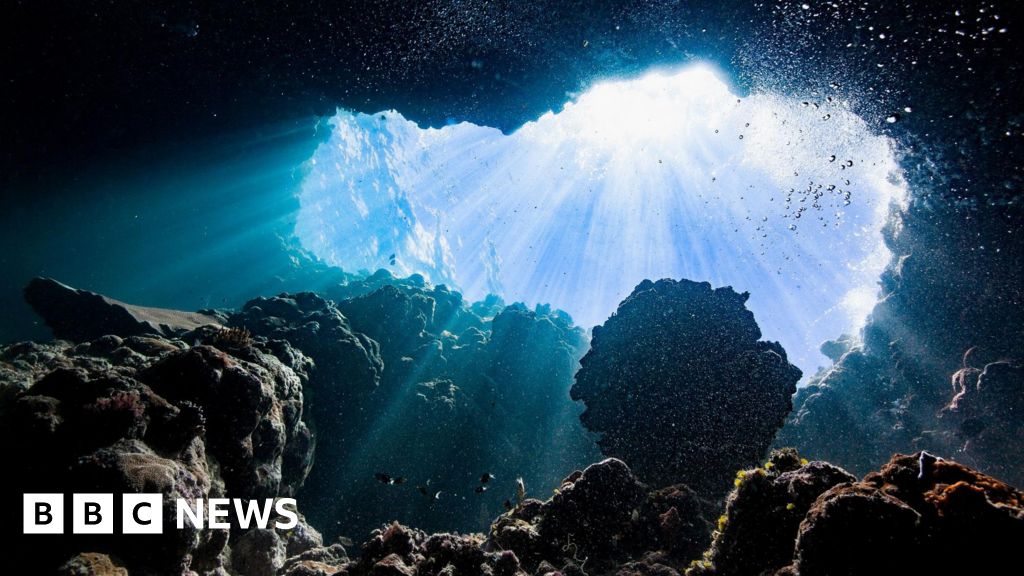Scientists have discovered “dark oxygen” being produced in the deep ocean, apparently by lumps of metal on the seafloor.
About half the oxygen we breathe comes from the ocean. But, before this discovery, it was understood that it was made by marine plants photosynthesising - something that requires sunlight.
Here, at depths of 5km, where no sunlight can penetrate, the oxygen appears to be produced by naturally occurring metallic “nodules” which split seawater - H2O - into hydrogen and oxygen.
Several mining companies have plans to collect these nodules, which marine scientists fear could disrupt the newly discovered process - and damage any marine life that depends on the oxygen they make.
I just learned of these lumps of metal, and I already care more about them than any CEO.
Dark thoughts get behind me, wait a second. We have metals on land. Research is needed to determine if we can magnify this process.
We can, it’s just electrolysis. All you need is electricity, and these nodules are simply batteries.
We’re not short of oxygen up here though, so it’s not terribly useful. We could get hydrogen that way, which would be greener than the way we get it at industrial scale now, but it would be way more expensive
Electrolysis I get. These never ending ‘batteries’ though ???
They should last indefinitely so long as the process of accretion which created these nodules keeps going. A battery becomes drained when the chemical interaction between the two metals uses up all the available metal, which happens quite fast in our modern batteries because we’ve designed them that way.
We’ve made them powerful and cheap by using relatively small amounts of each metal, spread thin and sandwiched together. The downside is that those things films of metal get used up fast.
These nodules, meanwhile, are lumps of metal. They won’t produce lots of power all at once, but they can generate small amounts for ages, and so long as they grow faster than the metal gets used up (it doesn’t actually go anywhere, it just changes chemically) they’ll keep going
Chemical reaction that basically through charge split water into basic elements slowly through direct interaction.
Like a magnet never runs out of magnetism juice but isn’t nearly as strong as an electromagnet. These are just a bunch of metals that clumped together.
Electrolysis requires an electric current, so energy. What I don’t understand from this article is where that energy is coming from. Magnets have nothing to do with it, they don’t produce energy. Batteries do, and different metals in salt water may act as a battery, but then they get used up in the process.
What are you taking a test on this?
They are lumps of conductive metals that when touching create a small charge that is able to respond to the charge that is held by water to be able to strip the oxygen atoms off.
It’s just a bunch of them in series together finally surpasses the threshold, they just all hold a very weak charge potential individually my comparison to magnets was meant to just imply that they naturally hold a very weak charge that isn’t a strong force like a more direct applied method would.
Taking a test lol no, way too old for that. But while these lumps of metal in sea water may generate some electricity, I can’t see them magically lining up in series like in a 9V battery, and below a certain voltage (1.5) there is no electrolysis - not even a little bit. But I have since found the original article and raw data, and it seems the people that wrote it don’t know either exactly how this oxygen is created.
You seem hung up on electricity being a literal function of this here. Expecting them to be a literal battery.
They said they knew how. The nodules have a potential charge, when touching it increases the charge which means it can separate the oxygen. There is already companies that are performing hydrogen separation without electricity on water.
The voltage potential is grabbing at the polar ends with likely a light chemical interaction with the zinc and other volatile metals present.
An exact process might not be here but the function here makes sense as long as you stop looking for direct current.
Edit: also this is not some rapid process this is a slow trickle. Nothing fancy just the physics of the world inspiring entropy.
We’re not short of oxygen up here though …
How do you know that before further studies can verify how much the nodules are contributing to the earth’s oxygen levels?
I know that for two reasons: first, we already know that oxygen concentration in the deep ocean is generally pretty low compared to the surface, and second we can already account for the general composition of our atmosphere. There just isn’t a big chunk of mystery oxygen who’s source we can’t identify.
While it’s not impossible that we’re mistaken and a bunch of it is coming from somewhere other than where we expect, it’s sufficiently unlikely that I’m comfortable making such statements I told and unless presented with evidence to the contrary.
The question posed was not what the impact would be if this source of oxygen were mined, and thus no longer contributing oxygen. The question was whether or not we could replicate this on the surface as a source of oxygen.
The answer is that it simply is not necessary. We have plenty of oxygen, what we need are means to sink CO2, which electrolysis does not do.
Seems monumental, I’m curious about more specific properties of the metal.
Seems like a valuable resource from a video game that charges science fiction energy drives.
It’s funny the title is “defies knowledge of the deep ocean”, given how often it’s proven humans have so little knowledge of the deep ocean in the first place.
The article is being pretty hyperbolic. There’s no mystery here, this is just something which happens if you put two different metals together. It’s nothing more or less than a crude battery, just like the ancestors of the AA battery the article kept harping on about.
This discovery could be important for people studying the climate on very early Earth, people studying early life, and the ecology of the deep sea today.
That last one is particularly troubling, though. If this is widespread, then this might be a major source of what little oxygen is down there. If so, then taking those nodules away (like a lot of people are keen to do, since some of the metals they’re made of are valuable) could destroy an entire ecosystem.
More research is required
I mean the article is being hyperbolic I think to try and sway opinion away from thinking it’s a good idea to mine these nodules.
We have a bunch of billionaires who are suddenly excited to go full Dune on the ocean floor for scraps of metal that aren’t currently on owned land and will fuck up the ecology just because it will finally make them more wealthy.
If it seems like there is grand mysteries and a impact on us instead of just all the low lying marine life it might get people to say it’s a bad idea and public opinion will get them to stop.
It’s just a shame that Shame doesn’t work as well as it used to to control people.
Do you understand how the metal becomes a battery and how it can work consistently to split hydrogen and oxygen?
How it’s naturally charged and recharged?
Not OP, and I could be completely wrong on how these specific things work, but it seems to me like they work as a rudimentary voltaic pile:https://en.m.wikipedia.org/wiki/Voltaic_pile
Take a look at the diagram, and imagine a metal alloy or even little bits of metal close to each other, and imagine the electrolyte is seawater.
It’s a super basic accidental nature battery.
Just wait until you hear about basic accidental nature nuclear reactors… And no, I’m not joking.
SCIENCE, BITCH!
I would expect it to work like a galvanic anode.
What seems to be the original study:
https://www.nature.com/articles/s41561-024-01480-8#Sec14
TLDR, they aren’t sure where the (small amounts) of oxygen comes from. And while the article is full of numbers, the section on measuring voltage from these lumps does not contain any. The raw data suggests (to me as a non expert) that the voltages measured are way too low for electrolysis of water (which requires >1.5V)
Based on what I understand about life, it’s probably microscopic extremophiles that decided hell was a good place to start reproducing.
Let’s fuck
Any random extremophile when faced with an unwelcoming environment
I like that theory
Could it be a new catalyst, that lets the process happen slowly over time, at lower voltages?
More guesses after I read the thingy
I just learned about this from John Oliver. The episode came out about a month ago. Doesn’t sound like a great idea to go after them, of course…
His take is spot on. It’s totally worth watching and thanks for sharing.
Scientists have discovered…
Several mining companies have plans to collect these…A tale as old as
timescience“Several mining companies have plans to collect these nodules”
Of course there are. This why we can’t nice things.
Nestlé is already planning to monopolize oxygen.
naturally occurring metallic “nodules” which split seawater - H2O - into hydrogen and oxygen.
Where have I heard this before? Oh yes
Color me deeply skeptical that these seafloor “batteries” have not been depleted. Extraordinary claims require extraordinary evidence. We need to overcome the possibility of faulty measurements or other sources.
Since the paper was just published yesterday I’m unsure why you would think the nodules are depleted.
The review standards for nature geoscience are pretty high, I think they will have thought of that
Nature journals have published plenty of wrong and sometimes fraudulent work. I agree it is difficult to publish in them, but that’s no guarantee.
I could definitely be wrong, but time will tell.
Sure they have; nonetheless the chances are dramatically lower than elsewhere. When they do that, it’s news.
Spoken like someone who doesn’t even know how a household battery works and has absolutely no idea how they’re different than this who just wanted to be contrary.





